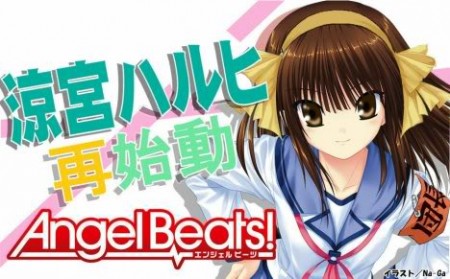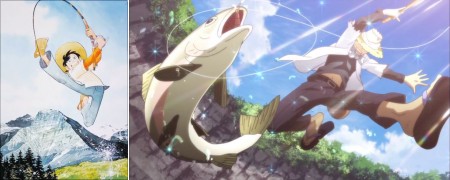Ask John: What Distinguishes an Otaku Pandering Anime?
Question:
In a recent viewing journal entry, you said, “So far, this series [Angel Beats!] strikes me as the epitome of ‘giving fans what they want.’ As long as Angel Beats continues to be self-aware and pander to popular otaku interests, it doesn’t have to actually make sense in order to be popular and successful.” Just to clarify, what are some signs that an anime — for example, Angel Beats! — is pandering to otaku audiences?
Answer:
To be fair to myself and the show, I perceived the Angel Beats! anime television series as an instance of nonsensical otaku pandering early in its broadcast. While I still believe that the show consciously hits particular “beats” appealing to the otaku community, I will concede that as the show approaches its conclusion it has clarified its narrative a bit, somewhat reducing its tone of arbitrary nonsense. The Angel Beats! anime is an original creation from Maeda Jun, popular scenario writer for hit visual novel games including Kanon, Air, Clannad, Tomoyo After, and Little Busters. Since Angel Beats was created by a craftsman whose work is very popular among Japanese otaku – an artist reciprocally by now very familiar with the themes and elements that Japanese otaku consider appealing – there should be no surprise that Angel Beats! seems like an adaptation based primarily around ensuring that it includes every point from a pre-established checklist of necessary features.
I’m not the only observer to notice that Angel Beats! primary supporting character Yuri is strikingly similar to popular character Suzumiya Haruhi. Yuri is assertive, demanding, capable, and certainly not adverse to sacrificing others to achieving her goals which she presumes are everyone’s goals. Further paralleling the popular Suzumiya Haruhi franchise, Yuri is the leader of an insulated school club; in this case, not the S.O.S. but the S.S.S. Yuri is surrounded by an assortment of characters, many of which exist to represent popular character archetypes. Main character Yuzuru Otonashi is the ideal simulation game protagonist. Like Suzumiya Haruhi’s Kyon, Otonashi is wise enough to think independently yet still a typical Japanese teen boy that viewers can relate to – someone willing to go along with the flow and submit to the dominant order. The fact that he eventually develops his own agenda simply adds appealing nuance to his character. Similarly, Kanade Tachibana, the angel, is an idealized female. She’s a figurative angel for viewers to idolize and adore because, akin to the dual-faceted tsundere personality, Kanade is composed and strict yet has a hidden idiosyncrasy – her fondness for spicy curry – that humanizes her. She’s good at schoolwork and she has supernatural battle abilities. She’s the idealized perfect Japanese girlfriend who is submissive to a man’s requests yet still capable of making decisions and taking conclusive action when necessary. Shiina is the requisite tsundere – diligent to a fault but with a weakness for cute stuffed animal toys. She’s strikingly reminiscent of Fate/stay night’s Saber. TK is the appealing enigma; his idiosyncratic hip-hop personality and mysterious use of English make him novel and unique without making him intimidating and foreign. Ayato Naoi’s fawning respect for Otonashi seems specifically included to inspire yaoi fantasies. Takamatsu’s glorious bare chest similarly seems like a conscious parodical reference to bishounen tradition. Yui is the requisite magical dojikko. Although Yui isn’t a fairy, her devil-themed outfit and clumsy personality stand in for cameo characters like Nogizaka Haruka’s Dojikko Aki-chan and Fight Ippatsu! Jyuden-chan’s Millie-chan. Yui is also the series’ most obvious self-referential character considering her tendency to consciously behave like a cliche anime character – for example, being the character that constantly has to interrupt class for restroom breaks in episode 5. The fact that Yuri refers to characters not involved with the SSS as “NPCs” further enhances the show’s subtle acknowledgment of artificiality and similarity to familiar tropes. The series’ procedure of slowly revealing its characters’ tragic histories and private sufferings gives the characters depth – although it may be cliche, tragic depth typical of bishoujo games – that makes the characters sympathetic and gives viewers greater ability to invest in and psychologically analyze their favorite characters.
The characters alone are not the only “fan service” aspect of the show. Following the pattern established by earlier otaku-oriented dramas including Manabi Straight, Suzumiya Haruhi, K-On, and Umineko no Naku Koro ni, Angel Beats includes performances by a girl rock band. The Angel Beats! first episode climactic shot of Kanade amid a flurry of meal tickets seems an homage and parody of the stereotypical bishoujo game “sad girl in snow” trope. Angel Beats!’s tendency, especially in its early episodes, to include ridiculous, violent physical comedy including instant death traps and characters suffering violent, bloody deaths only to be later revived as if nothing happened harkens to the slapstick humor prevalent in bishoujo games and the “reset” characteristic of the popular “Higurashi” and “Umineko” franchises. Similar to the tendency of particularly Lucky Star to pay homage to vintage, nostalgic anime, Angel Beats episode 7 includes a prominent homage to Tsurikichi Sanpei. Conscious artificiality such as episode 5’s slow-motion replays seem specifically included as a humorous and memorable “service” for viewers. The concept of children opposing and mistrustful of adults is an anime tradition that dates back to at least 1970’s Fushigi na Melmo. Angel Beats! includes not only that concept, but escalates it to teens opposing God.
It’s not my intention to criticize Angel Beats!, only critique it. Likewise, I can’t fault viewers for becoming engrossed in a show that’s so carefully and masterfully designed to achieve exactly that effect. I also don’t want to suggest that the characteristics of Angel Beats! can or should be applied to analysis of other anime series. Although Angel Beats! is an original anime production, it was created by an artist prominently known for composing bishoujo games, and Angel Beats! was specifically designed to be a popular multi-media franchise appealing to the same audience that supports bishoujo games. While Angel Beats! does everything it does well, practically everything the show does is knowingly and manipulatively planned to achieve a desired effect. The series cast is populated by characters that represent specific popular character archetypes. The series employs techniques and tropes that have been successful in previous otaku programs, including featuring a girl rock band, giving characters tragic pasts or tragic destinies, including obscure references to nostalgic anime, and including satirical awareness of its own artificiality and adherence to genre. These sort of tell-tale signs appear in numerous anime that consciously attempt to exploit the interests of viewers, including Umineko, Seitokai no Ichizon, and Mayoi Neko Overrun, to name a few. The artificiality of these shows doesn’t necessarily make them bad. In a case such as Seitokai no Ichizon, the exploitation of contemporary stereotypes and conventions wasn’t enhanced by anything else, resulting in a bland show. Series like Angel Beats! are recycling countless tropes widely recognized as being attractive and interesting to otaku, but shows like Umineko and Angel Beats! offer more than just a bare serving of rehashed tropes, which makes them uniquely interesting. Shows like Angel Beats! can be legitimately accused of lacking originality or creativity. They can also be approached as fascinating instances of anime doing something new and interesting with well-worn material.
Add a Comment
You must be logged in to post a comment.



